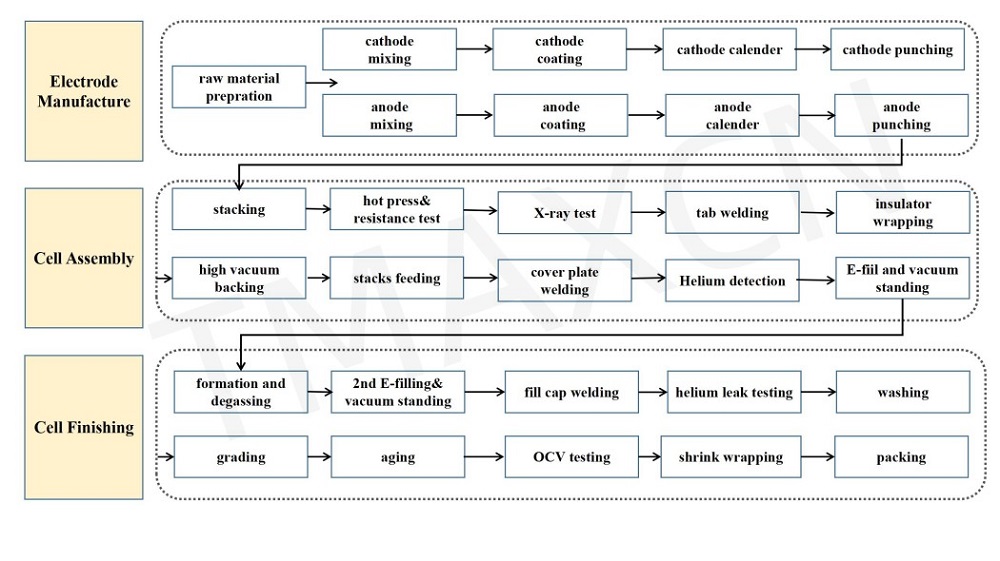Prismatic Cell Assembly: A Detailed Guide
Prismatic cells are one of the most common battery formats used in applications ranging from electric vehicles to consumer electronics. These cells are characterized by their rectangular shape, which allows for efficient use of space and high energy density. The assembly of prismatic cells involves several intricate steps, each requiring precision and control. This guide outlines the key steps, equipment, advantages, and challenges involved in prismatic cell assembly.
Key Components of Prismatic Cells
Cathode: Typically made from lithium metal oxides like LiCoO2, LiMn2O4, or NCM (Nickel Cobalt Manganese).
Anode: Generally composed of graphite or other carbon-based materials.
Separator: A thin, porous membrane that prevents direct contact between the cathode and anode while allowing ionic movement.
Electrolyte: A lithium salt dissolved in a solvent, facilitating the movement of lithium ions between the electrodes.
Current Collectors: Aluminum foil for the cathode and copper foil for the anode.
Casing: A rectangular metal or plastic housing that encases the cell components and provides structural integrity.
Steps in Prismatic Cell Assembly line
1. Electrode Preparation
Mixing: Active materials (cathode and anode), binders, and conductive additives are mixed with a solvent to form a slurry.
Coating: The slurry is coated onto current collector foils using an electrode coater.
Drying: The coated electrodes are dried to remove the solvent and solidify the active material.
Calendering: The dried electrodes are passed through rollers to compress them to the desired thickness and density.
Cutting: The electrodes are cut into precise shapes and sizes to fit into the prismatic cell casing.
2. Assembly
Stacking/Winding: Depending on the design, the electrodes and separators are either stacked in layers (stacked assembly) or wound into a jelly roll (wound assembly).
Insertion: The electrode assembly is inserted into the prismatic cell casing.
Electrolyte Filling: The casing is filled with electrolyte to ensure complete wetting of the electrodes.
Sealing: The cell casing is sealed using laser welding or crimping to ensure it is airtight and prevents leakage of the electrolyte.
3. Formation and Aging
Formation: The cells undergo a series of charge and discharge cycles to form a stable SEI (Solid Electrolyte Interphase) layer on the anode and ensure consistent performance.
Aging: The cells are stored for a period to allow for stabilization of electrochemical properties.
4. Testing and Quality Control
Electrical Testing: Each cell is tested for voltage, capacity, internal resistance, and other parameters to ensure they meet the required specifications.
Leak Testing: Cells are inspected for electrolyte leakage and casing integrity.
Safety Testing: Cells undergo various safety tests, including short-circuit, overcharge, and thermal stability tests.
Equipment Used in Prismatic Cell Assembly
Mixers: For preparing electrode slurries.
Coating Machines: To apply the slurry onto current collector foils.
Drying Ovens: For removing solvents from coated electrodes.
Calendering Machines: To compress the electrodes to the desired thickness and density.
Cutting Machines: For precise cutting of electrodes.
Stacking/Winding Machines: For assembling the electrodes and separators.
Electrolyte Filling Machines: To fill the cells with electrolyte.
Sealing Machines: For sealing the cell casing.
Formation Equipment: For initial charging and cycling of the cells.
Testing Equipment: For electrical, leak, and safety testing.
Advantages of Prismatic Cell Assembly
High Energy Density: The rectangular shape allows for efficient use of space, providing high energy density.
Design Flexibility: Prismatic cells can be designed in various sizes to fit specific applications.
Structural Integrity: The robust casing provides good mechanical stability.
Thermal Management: The flat surfaces of prismatic cells facilitate better thermal management compared to cylindrical cells.
Challenges in Prismatic Cell Assembly
Manufacturing Precision: Achieving uniform coating and precise assembly is critical for performance and safety.
Electrolyte Filling: Ensuring complete and uniform wetting of the electrodes can be challenging.
Sealing: Achieving a reliable seal to prevent electrolyte leakage is crucial.
Quality Control: Maintaining consistent quality across large production batches requires rigorous testing and control measures.
Development Challenges
Material Innovations: Developing new materials that offer higher energy densities, longer cycle life, and better safety profiles.
Process Optimization: Improving manufacturing processes to enhance efficiency and reduce costs.
Scaling Production: Scaling up production to meet the growing demand for prismatic cells, especially for electric vehicles and grid storage.
Environmental Impact: Addressing the environmental concerns related to the production and disposal of lithium-ion cells.
Conclusion
Prismatic cell assembly is a complex process that requires precise control and high-quality standards. The rectangular shape of prismatic cells offers advantages in energy density and design flexibility, making them suitable for a wide range of applications. However, challenges related to manufacturing precision, electrolyte filling, sealing, and quality control must be addressed to ensure consistent performance and safety. As the demand for high-performance batteries continues to grow, advancements in materials, processes, and technologies will play a critical role in the evolution and adoption of prismatic cells in various industries.

 es
es en
en fr
fr de
de ru
ru pt
pt ko
ko tr
tr pl
pl th
th







 Compatible con red IPv6
Compatible con red IPv6